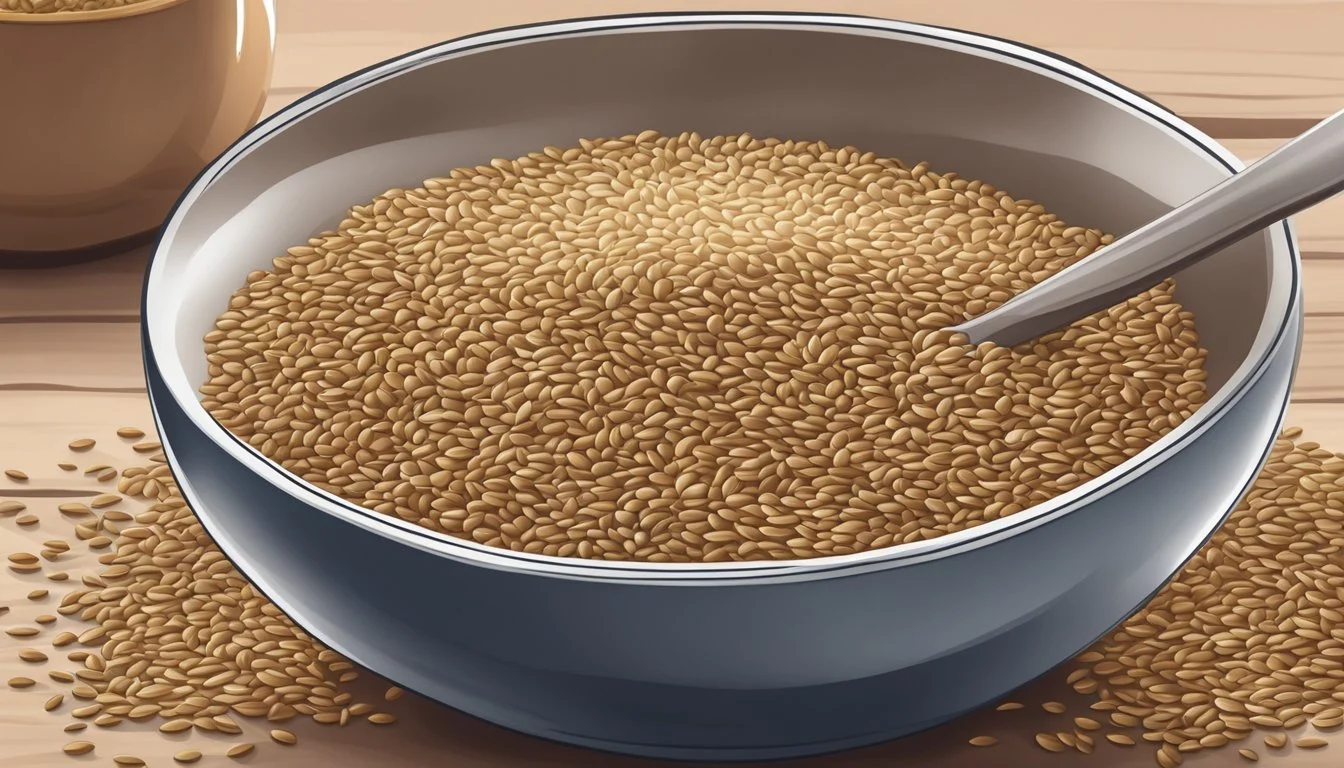Flax Egg Substitutes
Top Choices for Vegan Baking
Flax eggs have emerged as a popular vegan alternative to traditional eggs in baking. They are made by combining ground flax seeds with water, which when mixed and allowed to sit, thickens and forms a consistency similar to that of an egg. This substitute is not only beneficial for those following a vegan diet but also for those with egg allergies or dietary restrictions that limit the consumption of eggs.
The flax egg is prized in the culinary world for its health benefits, including a high content of omega-3 fatty acids and dietary fiber. When it comes to baking, flax eggs contribute moisture and can act as a binding agent, although they may not provide the same leavening or structure that eggs do. However, for many recipes, flax eggs can be an excellent substitute and are relatively easy to prepare.
Understanding the proper ratio for creating a flax egg is crucial for its success as an egg substitute. Typically, the ratio is one tablespoon of ground flax seeds mixed with two and a half tablespoons of water to replace one egg. Once mixed, the combination should sit for a few minutes until it achieves the desired gel-like consistency. Bakers can then incorporate this mixture into various recipes as an egg replacement, keeping in mind that its efficiency may vary depending on the type of baked good.
Understanding Egg Substitutes
In baking, eggs play a crucial role, and finding the right substitute is essential for those seeking egg-free options. Whether it's due to allergies, dietary preferences, or ethical reasons, alternatives must replicate the functions eggs typically serve.
Role of Eggs in Baking
Eggs are a fundamental ingredient in many baking recipes due to their multifunctional properties. They contribute to the texture, moisture, and flavor of baked goods. In terms of leavening, eggs help in rising and giving lightness to cakes and bread. They also act as a binding agent to combine ingredients and provide structure. The protein content in eggs aids in forming a stable batter or dough, essential for the consistency of the final product.
Why Use Egg Substitutes?
Individuals may opt for egg substitutes for various reasons. A common motive is the presence of an allergy to eggs, which necessitates an egg-free diet. Others may follow a vegan diet and avoid animal products, including eggs, due to ethical or health considerations. Another factor is the influence of vegan baking, where the demand for vegan egg substitutes is on the rise as alternatives to traditional ingredients. These substitutes aim to mimic the original qualities of eggs, like adding moisture and binding components to recipes. They must also be capable of integrating well with other flavors without overpowering the dish. Common egg replacements include plant-based ingredients like flax or chia seeds that, when mixed with water, can perform similar functions to an actual egg in baking.
Types of Vegan Egg Substitutes
When exploring vegan egg substitutes, it's important to understand the variety of options available. Each alternative serves a distinct purpose in cooking and baking, providing unique textures and binding properties.
Flax and Chia Seeds
Flaxseeds and chia seeds are popular choices for egg replacements due to their high soluble fiber content. To replace one egg, use 1 tablespoon of ground flaxseeds or chia seeds mixed with 2.5 tablespoons of water. This substitute is rich in omega-3 fatty acids and offers a mild, nutty flavor.
Fruit Purees
Fruit purees provide natural sweetness and moistness in baked goods. Applesauce and mashed banana are commonly used, with a quarter cup of puree equating to one egg. These options add flavor while reducing fat content, making them a wholesome choice for egg replacement.
Starches and Gums
Starches like tapioca starch and arrowroot powder are excellent thickeners. One tablespoon of cornstarch mixed with two tablespoons of water can substitute for an egg. These ingredients are ideal for achieving a desirable consistency in vegan recipes.
Dairy Alternatives
Plant-based dairy alternatives such as plant-based yogurt or unsweetened applesauce can replicate the binding qualities of eggs. A quarter cup of plant-based yogurt can be used in place of one egg, introducing a creamy texture to recipes.
Commercial Replacers
Store-bought egg replacers like Ener-G Egg Replacer are formulated to closely mimic eggs in baking. These replacers are typically made from a blend of starches and leavening agents and are measured to equal one egg per specified package instructions, providing convenience and consistency.
Each vegan egg substitute brings its own set of characteristics to the table, from the thickening prowess of starches to the binding abilities of seed gels, mimicking the multifaceted roles that eggs traditionally play in culinary applications.
Using Flax as an Egg Substitute
Flax eggs provide a plant-based alternative to chicken eggs in various baking recipes, offering a blend of fiber and a mild, nutty flavor. When properly prepared, they act as a binding agent in baking, making them especially suited for vegan recipes.
Preparing Flax Eggs
To prepare a flax egg, mix one tablespoon of ground flax seed with two and a half tablespoons of water. Stir the mixture and allow it to sit for about five minutes until it thickens to achieve a gelatinous consistency, similar to a beaten egg.
Best Uses for Flax Eggs
Flax eggs excel in vegan baking where the desired outcome is dense and moist, such as in brownies, muffins, and quick breads. Since flax eggs do not contain proteins that provide structure, they are less ideal for recipes that require a light and fluffy texture, like certain types of cakes or pancakes.
Flax Egg Ratios and Measurements
For an accurate substitution, use the following ratios:
Flax Egg Components Quantity Equivalent to Ground Flax Seed 1 tablespoon Water 2.5 tablespoons 1 chicken egg Ground Flax Seed 3 tablespoons jumbo egg Water 1.75 ounces (49g) medium egg Ground Flax Seed 2 tablespoons small egg Water 1.5 ounces (42g)
Incorporate this blend into your chosen recipe in place of traditional eggs, keeping the texture and flavor profile of your final product in mind.
Additional Tips for Vegan Baking
In vegan baking, precision is paramount. The absence of eggs necessitates careful adjustments in other ingredients to achieve the desired taste, structure, and moisture. Understanding the intricacies of vegan substitutes can greatly enhance the final baked goods.
Adjusting Baking Times and Temperatures
Incorporating substitutes such as flax eggs can affect how baked goods cook. Baking times may need to be reduced to prevent drying out, as flax eggs do not coagulate the same way chicken eggs do. Baking temperatures may also require slight adjustments; a lower temperature can help in evenly cooking without over-browning. Experimentation with each recipe is often necessary to determine optimal times and temperatures.
Ensuring Proper Moisture and Flavor
Achieving the right moisture balance is crucial in vegan baked goods. The use of flax eggs, which are made from ground flaxseed and water, can add moisture to recipes, but other liquids like oil or water may need to be fine-tuned. Similarly, flavors can be enhanced through the addition of vinegar or spices, as traditional egg flavors are absent.
Vinegar: When paired with baking soda, forms a reaction that adds lightness.
Oil: A touch extra can enhance the moistness and richness.
Balancing these elements lends a comparable taste and feel to their non-vegan counterparts.
Considerations for Texture and Density
The texture and density of baked goods depend highly on the combination of ingredients used. Vegan baking often employs baking soda and apple cider vinegar as leavening agents to counter the density that flax eggs might introduce.
To optimize for lighter textures: Add a teaspoon of baking soda with a tablespoon of vinegar as a replacement for an egg.
Herbs, nuts, or fruits can add variety in texture as well as nutritional value, but they should be incorporated thoughtfully to maintain balance in the overall composition.
Troubleshooting Common Issues
When incorporating flax or chia eggs as substitutes in vegan baking, it's not uncommon to encounter issues with binding, consistency, flavor, or color. This section offers practical solutions to address these challenges efficiently.
Dealing with Binding Problems
Flax eggs and chia eggs are popular binding alternatives in vegan baking and can usually be traded in for eggs on a 1:1 basis. However, they may not always provide the same level of structural integrity. To enhance the binding property, make sure to allow the flax or chia mixture to rest until it becomes gelatinous, typically for about 5 to 10 minutes. Additionally, increasing the resting period slightly can improve binding qualities, especially in recipes such as vegan french toast where cohesion is key.
Resolving Consistency Challenges
Sometimes, the consistency of the batter or dough isn't quite right with flax or chia eggs. To troubleshoot:
For too thin batter: Add an extra teaspoon of ground flax or chia seeds and wait a few minutes. The mixture should thicken as the seeds absorb the water.
For too thick batter: Slowly mix in water, a tablespoon at a time, to achieve the desired consistency without compromising the structure.
Consistency adjustments are often a matter of a test and tweak approach, especially when adapting a traditional recipe for vegan baking.
Fixing Flavor and Color Concerns
Unwanted flavor or color changes can occur when using flax or chia seeds. To minimize this:
Use golden flax seeds instead of dark ones to avoid a pronounced, nutty flavor and darker color that might affect light-colored baked goods.
If a recipe calls for a substantial amount of eggs, consider combining flax or chia eggs with other substitutions, like unsweetened applesauce, to maintain the original flavor profile.
Remember that while chia eggs can be used interchangeably with flax eggs, chia's distinct dark speckled appearance may not be suitable for all recipes. Conduct a small-scale test with the substitution to ensure it suits both the taste and appearance for the recipe.



